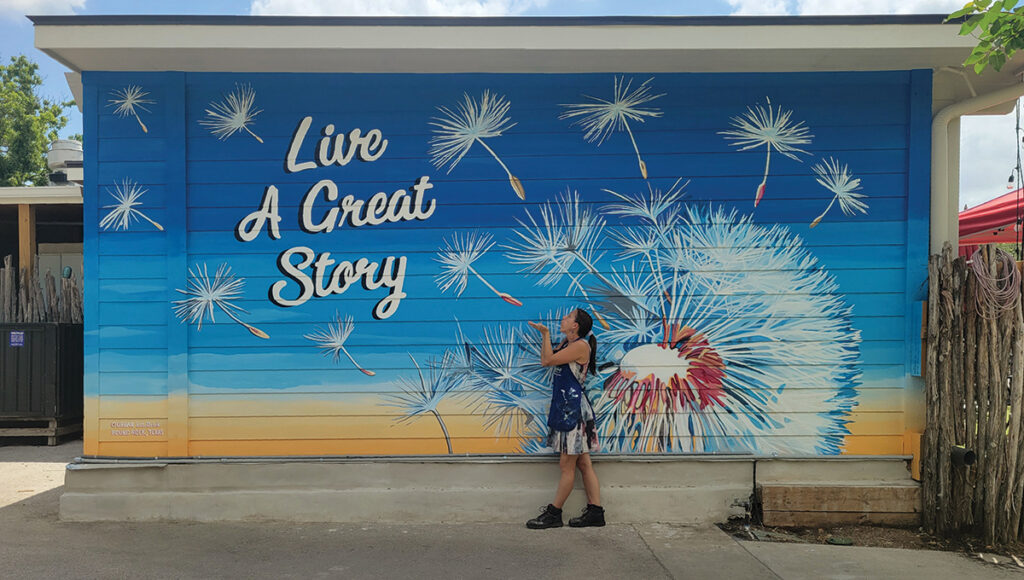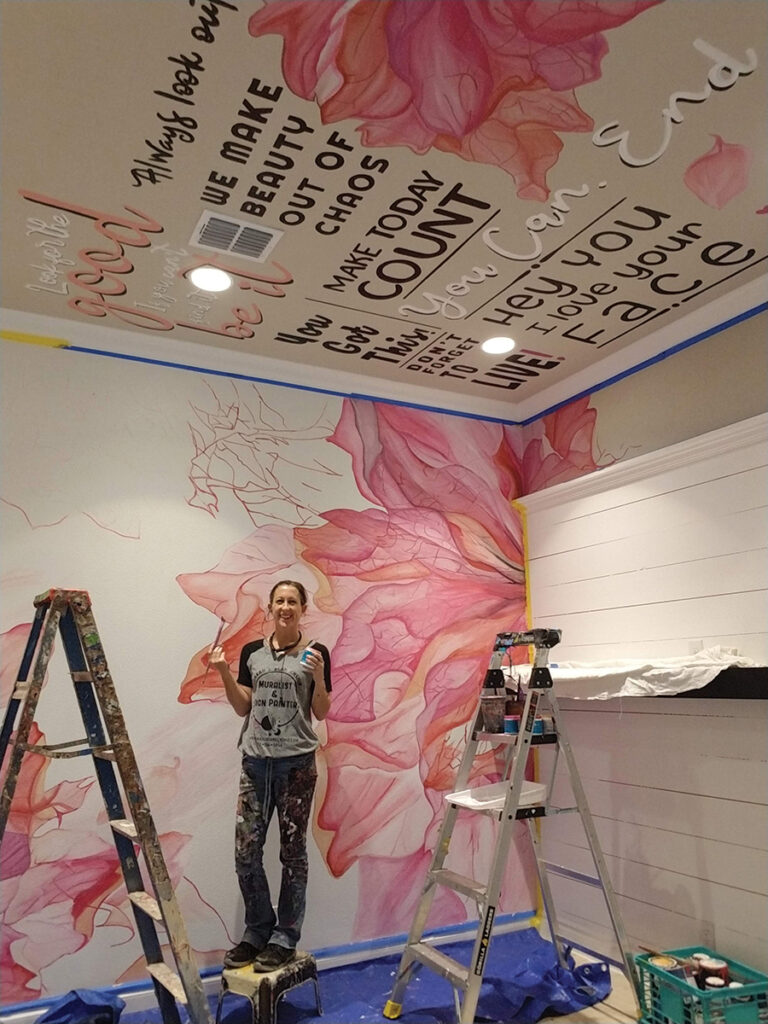It’s an exhausting job, but so gratifying.
Sarah Blankenship
Sarah Blankenship’s days have their ups and downs – literally, and few people have a voicemail message that reminds callers, “I’m often on scaffolding and can’t get to my phone.” But for this well-known muralist and sign painter, the physical demands, continual test of creativity, and required patience are all worth it.
We asked Sarah to share the ins and outs of muraling and what it takes to bring her works of art to life.
What is the difference between painting on canvas or paper compared to a building wall?
Setting: For canvas/paper, you can execute in the comfort of your home studio. You can also control the temperature, where you sit/stand, and who is around you. For wall murals, the location and surrounding environment change all the time. For exterior wall murals, expect changing weather conditions, visibility constraints of daylight hours, and standing for hours at a time.
Surface texture: Canvas is stretched across a wood frame and there isn’t a solid surface behind it, which creates some movement when you paint. Walls are a solid surface, which requires less of a delicate brush stroke. The paint that adheres best can vary on different wall textures/materials and the approach to painting can differ.
Subject matter: For a wall mural, my goal is to help achieve the vision of the business or homeowner, not necessarily mine. There is a lot more flexibility to simply create what you like as an artist on canvas/paper.

Does painting on buildings require different skills or techniques?
If you can paint small, you can learn how to paint big. The biggest difference is scale, speed, brush size, and ladders/scaffolding. You have to cover a lot more ground in a quick amount of time. A roller or a larger brush — the kind you use to paint house trim — is often needed to cover a large expanse, rather than small detail brushes more common in canvas painting.
What is your process from start to finish?
- Initial meeting/photos to visualize space and hear client’s vision
- Estimate
- Design: computer designs executed on top of the existing photo(s)
- Prep/set-up: purchase supplies, load truck with materials, ladder and/or scaffolding. Cover area. Set up. Trace design.
- Painting: that’s the best part for me!
- Clean up.
- Wrap up: touch ups/adjustments. Make sure client is happy.
- Invoicing

Does being a muralist require any certain training?
You don’t need certain training. I think people are born with artistic skill and many people out there already have the talents to paint a mural. What you do need is trial and error time with the best execution, materials, and methods that work for you. Practice in your home or a friend’s home, or volunteer on a community mural.
I did attend Savannah College of Art and Design and I know my classes on color theory, drawing, art history, computer art, etc. were helpful. What my college lacked was business classes. I’ve had to figure out how to write estimates, do invoicing, get business insurance, do my taxes and much more. I think business classes would be helpful to anyone looking to work for themselves in any industry.
Every muralist approaches their process slightly different. For me, computer design is essential to my process, so training in Photoshop and Illustrator was very helpful. Knowledge of Photoshop also allows me to quickly adjust scale and designs on site if my drawing doesn’t perfectly match up to on-site conditions.
How long does a typical project take?
Logos are often a day project, most murals take a week, larger murals are typically two weeks.
How do you scale your designs onto a wall in order to get accurate guidelines to work from?
It depends on the space and the surrounding environment. A projector is the easiest, quickest, and the most common way I transfer the design from the computer to the wall. If there is not enough room or site conditions aren’t conducive, I use the grid method, free-hand, stencils, tracing paper transfers, or a tape measure and level.
Are there any tips you can share for beginning muralists?
Sign painting workshops are helpful for lettering.
The level is your best tool for straight lettering.
Practice with sample size or discounted mis-tint paints from your local paint store.
You learn as you go, don’t be afraid to get out there and try!
Running a one-woman business was a conscious decision for Sarah. Her goal was to create a less complicated, more free-flowing environment in which she could devote herself to the reason behind it all – painting.
